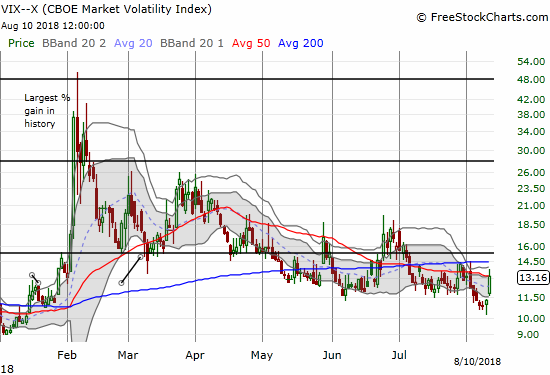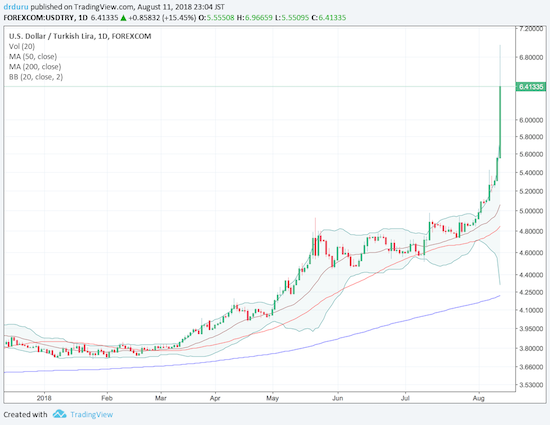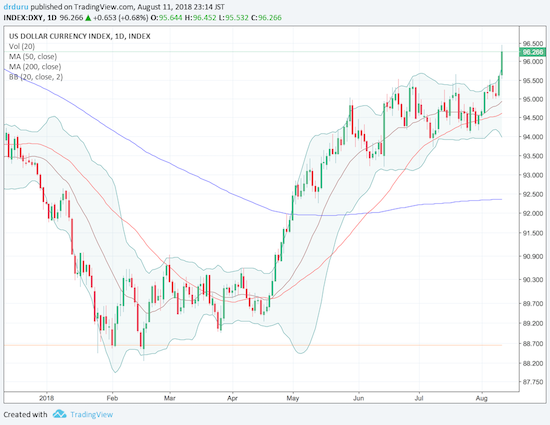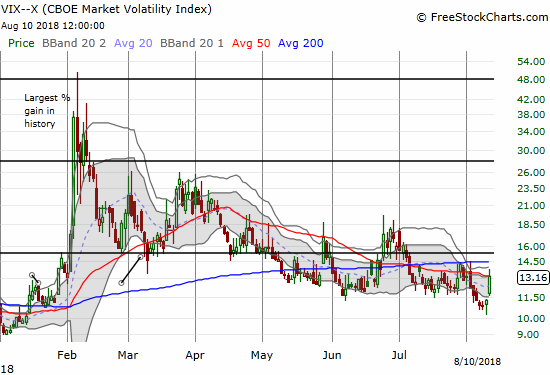The indicators barely changed from the last Above the 40 post, but the technical winds are likely changing yet again.
A little over a week ago, Apple’s (AAPL) the last Above the 40 post was willing the stock market higher. Since then, AAPL has gone exactly nowhere. AT40 (2108), the percentage of stocks trading above their respective 40-day moving averages (DMAs), has lost one percentage point. Like AAPL, AT200 (T2107), the percentage of stocks trading above their respective 200DMAs, has gone exactly nowhere. The NASDAQ and the Invesco QQQ Trust (QQQ) are up marginally (about half a percent). The volatility index, the VIX, is the only one of my major indicators and indices with a notable change since the last post: the VIX is up a point or 8.2% since then.

The volatility index, the VIX, jumped from extremely low territory but still faded from its high of the day.
As planned, I held a fist full of call options in ProShares Ultra VIX Short-Term Futures (UVXY) ready. I also took profits quickly given how regularly VIX faders succeed in pushing down these pops. I reloaded on Thursday as I conceded that the last tranche of UVXY calls would go out with a whimper. I was a bit surprised that the VIX held as well as it did even with the fade from its intraday high. As a result, I was not able to reload on UVXY call options at my preferred price point. I feel a little light on bearish bets with a single September SPY put option in place in addition to my small assortment of various shorts. Note well that the VIX jumped from extremely low levels (below 11). Those levels are typically a bullish indicator. However, in recent years the end of a period of ELV (Extremely Low Volatility) has tended to precede a large pullback (greater than 5%). The February swoon was a particularly significant example.
The heightened sense of risk came from screaming headlines about increasing tensions between the U.S. and Turkey (North Korea might soon be the last country with a deep beef with the U.S.). In a tweet, President Trump essentially bragged about taking down the Turkish lira (USD/TRY) as he threatened a doubling of aluminum and steel tariffs on the economically struggling country. The resulting volatility and plunge in value completely upset a neat strategy I had in place short USD/TRY to collect carry and short-term swings with long EUR/TRY.

Source: TradingView.com
The suffering of the Turkish lira reached epic proportions as USD/TRY gained as much as 16% on the day. USD/TRY is now up an astonishing 69% year-to-date.
Ironically, I was in the short USD/TRY and long EUR/TRY trade as a partial hedge on long U.S. dollar positioning. Needless to say, I had to abandon ship. Adding to my own pain is that the dollar surged against almost all major currencies at a point where I had a minimal long position in the dollar. The euro suffered the most as fears of currency contagion cascaded from Turkey to European banks.

Source: TradingView.com
The U.S. dollar index (DXY) broke out to a new 14-month high.
I am still as bullish as ever on the U.S. dollar. Yet with the index trading well above its upper-Bollinger Band (BB), I will have to exercise patience in rebuilding my next phase of dollar longs. Note well that inflation numbers (Consumer Price Index (CPI)) came in “hot” on Friday, essentially guaranteeing two more rate hikes from the Federal Reserve this year even as increasing macro-economic turmoil keeps tossing in major caveats. From the Bureau of Labor Statistics (emphasis mine):









Leave A Comment